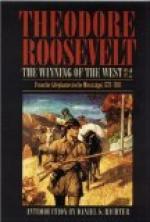CHAPTER X.
THE HOLSTON SETTLEMENTS TO THE END OF THE REVOLUTION, 1781-83.
John Sevier. John Sevier had no sooner returned from doing his share in defeating foes who were of his own race, than he was called on to face another set of enemies, quite as formidable and much more cruel. These were the red warriors, the ancient owners of the soil, who were ever ready to take advantage of any momentary disaster that befell their hereditary and victorious opponents, the invading settlers.
For many years Sevier was the best Indian fighter on the border. He was far more successful than Clark, for instance, inflicting greater loss on his foes and suffering much less himself, though he never had any thing like Clark’s number of soldiers. His mere name was a word of dread to the Cherokees, the Chickamaugas, and the upper Creeks. His success was due to several causes. He wielded great influence over his own followers, whose love for and trust in “Chucky Jack” were absolutely unbounded; for he possessed in the highest degree the virtues most prized on the frontier. He was open-hearted and hospitable, with winning ways towards all, and combined a cool head with a dauntless heart; he loved a battle for its own sake, and was never so much at his ease as when under fire; he was a first-class marksman, and as good a horseman as was to be found on the border. In his campaigns against the Indians he adopted the tactics of his foes, and grafted on them some important improvements of his own. Much of his success was due to his adroit use of scouts or spies. He always chose for these the best woodsmen of the district, men who could endure as much, see as much, and pass through the woods as silently, as the red men themselves. By keeping these scouts well ahead of him, he learned accurately where the war parties were. In the attack itself he invariably used mounted riflemen, men skilled in forest warfare, who rode tough little horses, on which they galloped at speed through the forest. Once in position they did the actual fighting on foot, sheltering themselves carefully behind the tree-trunks. He moved with extreme rapidity and attacked with instantaneous suddenness, using ambushes and surprises wherever practicable. His knowledge of the whereabouts and size of the hostile parties, and the speed of his own movements, generally enabled him to attack with the advantage of numbers greatly on his side. [Footnote: The old Tennessee historians, headed by Haywood, base their accounts, of the actions on statements made by the pioneers, or some of the pioneers, forty or fifty years after the event; and they do a great deal of bragging about the prowess of the old Indian fighters. The latter did most certainly perform mighty deeds; but often in an entirely different way from that generally recorded; for they faced a foe who on his own ground was infinitely more to be dreaded than the best trained European




